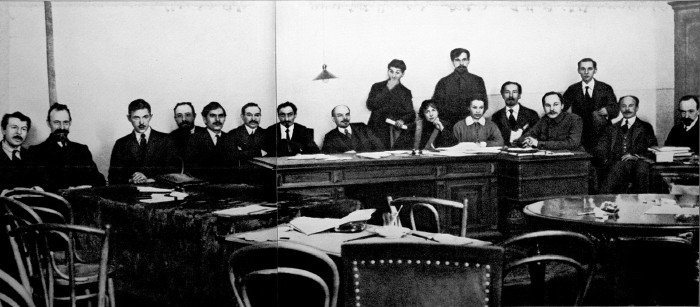Council of People's Commissars
Council of People's Commissars (Rada Narodnykh Komisariv or Radnarkom; Russian: Sovet Narodnykh Komissarov or Sovnarkom). Supreme executive and administrative body in the Union of Soviet Socialist Republics and the Ukrainian Soviet Socialist Republic until 1946. It was first established as the government of the Russian Soviet Federated Socialist Republic under Vladimir Lenin's leadership by the Second All-Russian Congress of Soviets in November 1917. In 1923 the Sovnarkom of the USSR became the Union government responsible to the Central Executive Committee and its presidium. It consisted of Union (amalgamated) commissariats and federated commissariats (the latter functioned also in the republican Sovnarkoms). The structure of the Sovnarkom of the USSR changed continually as the government became increasingly centralized, particularly after 1934, when the functions of the All-Union and the Union-republican commissariats were defined. The Sovnarkom was headed by Lenin (1917–24), A. Rykov (1924–30), Viacheslav Molotov (1930–41), and Joseph Stalin (1941–6). In 1946 it was renamed the Council of Ministers of the USSR.
In Ukraine the first Soviet government called itself the People's Secretariat in imitation of the General Secretariat of the Central Rada. The second Soviet government, formed on 30 November 1918, was known as the Provisional Workers' and Peasants' Government of Ukraine. It used this name until January 1919, when it adopted, after the Russian model, the name Council of People's Commissars of Ukraine (Radnarkom). For a short time in 1919–20 the Radnarkom was abolished, and its functions were carried out by the All-Ukrainian Revolutionary Committee. According to article 16 of the 1919 Constitution of the Ukrainian Soviet Socialist Republic, the Radnarkom had the right to examine all legislative and administrative matters, but it could rule only on those matters that were delegated to it by the All-Ukrainian Central Executive Committee. The constitution did not prescribe the number of people's commissars or define their functions. A number of government executive branches in Ukraine were directed by the appropriate people's commissariats of the Russian SFSR (eg, defense, foreign trade, postal and telegraph services, transportation), which had been granted jurisdiction by special treaties between Ukraine and Russia in 1919–21. The Russian commissars in charge of such areas were represented by deputies in the people's commissariats of Ukraine.
After the formation of the Union of Soviet Socialist Republics in 1923, the jurisdiction of the central agencies of the Soviet Union was limited somewhat: the Sovnarkom of the USSR received from the Central Executive Committee of the USSR legislative authority only over the more important government matters.
The Radnarkom consisted of the people's commissars of Ukraine, their deputies in the government of Ukraine, the deputy of the State Political Administration (GPU) of the USSR, and other members who were designated by the Central Executive Committee. In accordance with the 1924 Constitution of the USSR, Ukraine had eleven commissariats, five of which had the same name as their all-Union counterparts: finance, labor, workers'-peasants' inspection, supplies (later called internal trade), and the Higher Economic Council. The other six commissariats—justice, internal affairs, education, social security, land affairs, and public health—were independent. In addition, the Radnarkom included five deputies of the Union (amalgamated) commissariats: foreign affairs, military and naval affairs, foreign trade, roads and highways, and postal and telegraph services. These deputies, according to the decision of the Central Executive Committee of the USSR, functioned in an advisory capacity but also had the right to cast a decisive vote.
The 1936 constitution retained this division of powers in principle, but introduced new names for the commissariats. The Union commissariats directed their designated branches of administration throughout the USSR directly or through subordinate agencies; the Union-republican commissariats directed their corresponding branches, based on registers of enterprises or institutions, through republican commissariats of the same name; and the republican commissariats were responsible only to the councils of people's commissars in their own republics. Besides the commissariats, state committees and central administrations such as the State Planning Committee and the Chief Administraiton of Workers' Recruitment and Resettlement belonged to the Radnarkom. After the reform of the economic administration in 1932–4, the number of USSR people's commissariats increased. In accordance with the official theory the Council of People's Commissars became the highest administrative body, carrying out within its jurisdiction and under the leadership of the Communist Party of the Soviet Union the duties of the government of the Soviet state.
Formally, the chairman and the members of the Radnarkom were appointed by the All-Ukrainian Central Executive Committee and, starting in 1937, by the Supreme Soviet of the Ukrainian SSR, to which the Radnarkom reported and was responsible. In reality, decision making belonged to the Moscow leadership of the Communist Party of the Soviet Union and the Central Committee of the Communist Party of Ukraine. The Radnarkom functioned under their control. The council's decisions took the form of decrees and decisions according to the Soviet constitution of 1924 and of decisions and ordinances according to the 1936 constitution.
The chairmen of the Radnarkom from 1919 to 1946 were Khristian Rakovsky (1919–23), Vlas Chubar (1923–34), Panas Liubchenko (1934–7), M. Bondarenko (1937), Demian Korotchenko (1938–9), Leonid Korniiets (1939–44), and Nikita Khrushchev (1944–6).
In 1946 the Radnarkom was renamed the Council of Ministers of the Ukrainian SSR, and the people's commissariats became ministries.
A. Bilynsky
[This article originally appeared in the Encyclopedia of Ukraine, vol. 1 (1984).]
